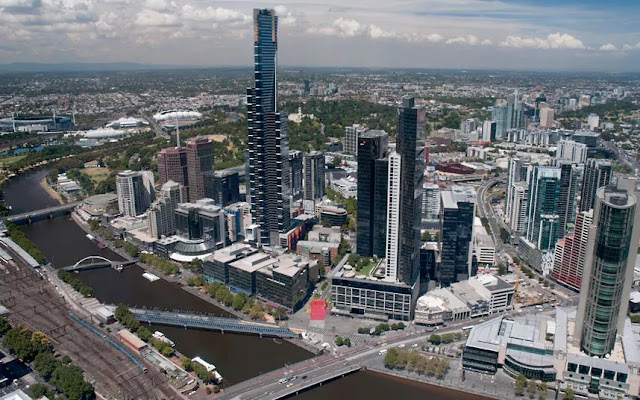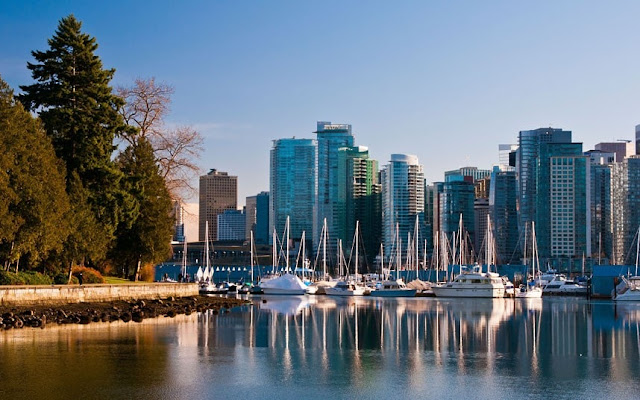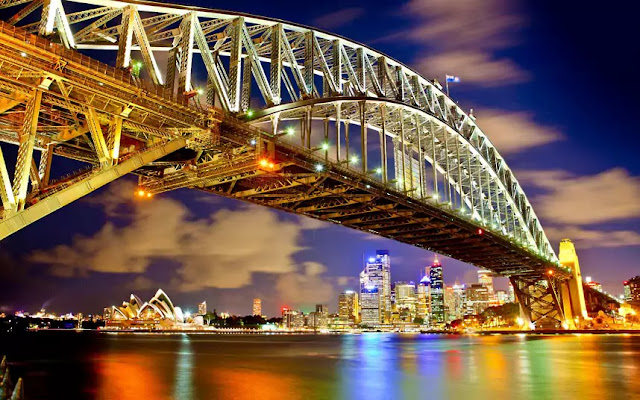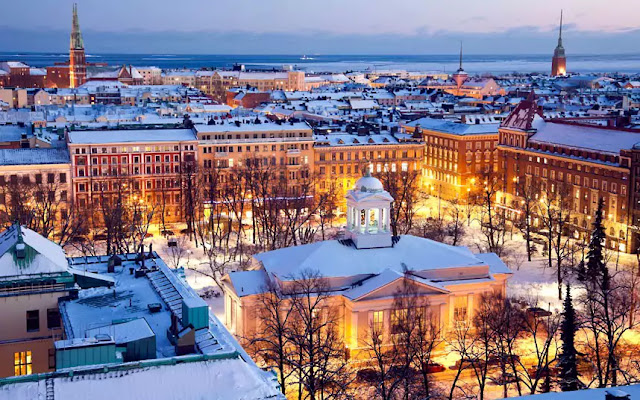The World's Top Best Cities To Live In
According to the Economist Intelligence Unit global “liveability” study, which looks at how “tolerable” it is to live in a particular place given its crime levels, threat of conflict, quality of medical care, levels of censorship, temperature, schools and transport links.
1. Melbourne, Australia ---------- Picture: Philip Game / Alamy
Founded by free settlers from the British Crown colony of Van Diemen's Land on 30 August 1835, in what was then the colony of New South Wales,[15] it was incorporated as a Crown settlement in 1837.[15] It was named "Melbourne" by the Governor of New South Wales, Sir Richard Bourke, in honour of the British Prime Minister of the day, William Lamb, 2nd Viscount Melbourne.[15] It was officially declared a city by Queen Victoria, to whom Lord Melbourne was close, in 1847,[16] after which it became the capital of the newly founded colony of Victoria in 1851.[16] During the Victorian gold rush of the 1850s, it was transformed into one of the world's largest and wealthiest cities.[17] After the federation of Australia in 1901, it served as the nation's interim seat of government until 1927.[18]
Melbourne rates highly in education, entertainment, healthcare, research and development, tourism and sport,[19] making it the world's most liveable city—for the sixth year in a row in 2016, according to the Economist Intelligence Unit.[20] It is a leading financial centre in the Asia-Pacific region and ranks among the top 30 cities in the world in the Global Financial Centres Index.[21][22] Referred to as Australia's "cultural capital",[23] it is the birthplace of Australian impressionism, Australian rules football, the Australian film and television industries, and Australian contemporary dance. It is recognised as a UNESCO City of Literature and a major centre for street art, music and theatre. It is home to many of Australia's largest and oldest cultural institutions such as the Melbourne Cricket Ground, the National Gallery of Victoria, the State Library of Victoria and the UNESCO World Heritage-listed Royal Exhibition Building. It was the host city of the 1956 Summer Olympics and the 2006 Commonwealth Games.
The main passenger airport serving the metropolis and the state is Melbourne Airport (also called Tullamarine Airport), the second busiest in Australia. The Port of Melbourne is Australia's busiest seaport for containerised and general cargo.[24] Melbourne has an extensive transport network. The main metropolitan train terminus is Flinders Street Station, and the main regional train and coach terminus is Southern Cross Station. Melbourne is also home to Australia's most extensive freeway network and has the world's largest urban tram network.[25]
2
Apart from being regarded as the City of Music[14] because of its musical legacy, Vienna is also said to be "The City of Dreams" because it was home to the world's first psycho-analyst – Sigmund Freud.[15] The city's roots lie in early Celtic and Roman settlements that transformed into a Medieval and Baroque city, and then the capital of the Austro-Hungarian Empire. It is well known for having played an essential role as a leading European music centre, from the great age of Viennese Classicism through the early part of the 20th century. The historic centre of Vienna is rich in architectural ensembles, including Baroque castles and gardens, and the late-19th-century Ringstraße lined with grand buildings, monuments and parks.[16]
Vienna is known for its high quality of life. In a 2005 study of 127 world cities, the Economist Intelligence Unit ranked the city first (in a tie with Vancouver, Canada and San Francisco, USA) for the world's most liveable cities. Between 2011 and 2015, Vienna was ranked second, behind Melbourne, Australia.[17][18][19][20][21] For eight consecutive years (2009–2016), the human-resource-consulting firm Mercer ranked Vienna first in its annual "Quality of Living" survey of hundreds of cities around the world, a title the city still held in 2016.[22][23][24][25][26][27][28] Monocle's 2015 "Quality of Life Survey" ranked Vienna second on a list of the top 25 cities in the world "to make a base within."[29][30][31][32][33]
The UN-Habitat has classified Vienna as being the most prosperous city in the world in 2012/2013.[34] The city was ranked 1st globally for its culture of innovation in 2007 and 2008, and sixth globally (out of 256 cities) in the 2014 Innovation Cities Index, which analysed 162 indicators in covering three areas: culture, infrastructure, and markets.[35][36][37] Vienna regularly hosts urban planning conferences and is often used as a case study by urban planners.[38]
Between 2005 and 2010, Vienna was the world's number-one destination for international congresses and conventions.[39] It attracts over 3.7 million tourists a year
3
Addition: Vancouver is a coastal seaport city in Canada. Located in in the Lower Mainland region of British Columbia, it is the most populous city in the province. The 2016 census recorded 631,486 people in the city, up from 603,502 in 2011. The Greater Vancouver area (Metropolitan Vancouver) had 2,463,431 versus 2,313,328 in 2011, making it the third-largest metropolitan area in Canada. Vancouver has the highest population density in Canada with over 5,400 people per square kilometre.[4][5]
In the 2011 census, Vancouver was one of the most ethnically and linguistically diverse cities in Canada; 52% of its residents have a first language other than English.[6][7] Vancouver is classed as a Beta global city. Vancouver was the most densely populated Canadian municipality in the 2011 census too, with over 250,000 residents, and the fourth most densely populated city in North America behind New York City, San Francisco,[8] and Mexico City.
The original settlement, named Gastown, grew up on clear cuts on the west edge of the Hastings Mill logging sawmill's property, where a makeshift tavern had been set up on a plank between two stumps and the proprietor, Gassy Jack, persuaded the curious millworkers to build him a tavern, on 1 July 1867. From that first enterprise, other stores and some hotels quickly appeared along the waterfront to the west. Gastown became formally laid out as a registered townsite dubbed Granville, B.I. ("B.I" standing for "Burrard Inlet"). As part of the land and political deal whereby the area of the townsite was made the railhead of the CPR, it was renamed "Vancouver" and incorporated shortly thereafter as a city, in 1886. By 1887, the transcontinental railway was extended to the city to take advantage of its large natural seaport, which soon became a vital link in a trade route between the Orient, Eastern Canada, and Europe.[9][10] As of 2014, Port Metro Vancouver is the third largest port by tonnage in the Americas (displacing New York), 27th in the world,[11] the busiest and largest in Canada, and the most diversified port in North America.[12] While forestry remains its largest industry, Vancouver is well known as an urban centre surrounded by nature, making tourism its second-largest industry.[13] Major film production studios in Vancouver and Burnaby have turned Greater Vancouver and nearby areas into one of the largest film production centres in North America,[14][15] earning it the film industry nickname, Hollywood North.[16][17][18]
Vancouver is consistently named as one of the top five worldwide cities for livability and quality of life,[19][20] and the Economist Intelligence Unit acknowledged it as the first city to rank among the top-ten of the world's most liveable cities[21] for five consecutive years.[22] Vancouver has hosted many international conferences and events, including the 1954 British Empire and Commonwealth Games, UN Habitat I, Expo 86, the World Police and Fire Games in 1989 and 2009; and the 2010 Winter Olympics and Paralympics which were held in Vancouver and Whistler, a resort community 125 km (78 mi) north of the city.[23] In 2014, following thirty years in California, the annual TED conference made Vancouver its indefinite home. Several matches of the 2015 FIFA Women's World Cup were played in Vancouver, including the final at BC Place Stadium.[24]
4
Addition: Toronto is the most populous city in Canada and the provincial capital of Ontario.[12][13] With a population of 2,731,571,[6][12] Toronto is the fourth most populous city in North America after Mexico City, New York City, and Los Angeles. Toronto is the centre of the Greater Toronto Area (GTA), the most populous metropolitan area in Canada,[14] and anchors the Golden Horseshoe, a heavily urbanised region that is home to 8.7 million people,[15] or around 26% of the population of Canada.[16] A global city,[17] Toronto is an international centre of business, finance, arts, and culture,[18][19] and widely recognised as one of the most multicultural and cosmopolitan cities in the world.[20][21][22][23][24]
Aboriginal peoples have inhabited the area now known as Toronto for thousands of years. The city itself is situated on the southern terminus of an ancient Aboriginal trail leading north to Lake Simcoe, used by the Wyandot, Iroquois, and the Mississauga.[25] Permanent European settlement began in the 1790s, after the broadly disputed Toronto Purchase of 1787, when the Mississaugas surrendered the area to the British Crown.[26] The British established the town of York, and later designated it as the capital of Upper Canada.[27] During the War of 1812, the town was the site of the Battle of York and suffered heavy damage by U.S. troops.[28] York was renamed and incorporated as the city of Toronto in 1834 and became the capital of the province of Ontario during the Canadian Confederation in 1867.[29] The city proper has since expanded past its original borders through amalgamation with surrounding municipalities at various times in its history to its current area of 630.2 km2 (243.3 sq mi).
Located in Southern Ontario on the northwestern shore of Lake Ontario, Toronto is situated on a broad sloping plateau intersected by an extensive network of rivers, deep ravines, and urban forest,[30] with 140 independently unique and clearly defined official neighbourhoods making up the city.[31] The diverse population of Toronto reflects its current and historical role as an important destination for immigrants to Canada,[32][33] with nearly 50% of residents belonging to a visible minority population group,[34] and over 200 distinct ethnic origins represented among its inhabitants.[35] While the majority of Torontonians speak English as their primary language, there are over 160 different languages spoken in the city.[36]
Toronto is a prominent centre for music,[37] theatre,[38] motion picture production,[39] and television production,[40] and is home to the headquarters of Canada's major national broadcast networks and media outlets.[41] Its varied cultural institutions,[42] which include numerous museums and galleries, festivals and public events, entertainment districts, national historic sites, and sports activities,[43] attract over 25 million tourists each year.[44][45] Toronto is well known for its skyscrapers and high-rise buildings,[46] in particular the tallest free-standing structure in the Western Hemisphere, the CN Tower.[47] As Canada's commercial capital, the city is home to the Toronto Stock Exchange, the headquarters of Canada's five largest banks,[48] and the headquarters of many large Canadian and multinational corporations.[49] Its economy is highly diversified with strengths in technology, design, financial services, life sciences, education, arts, fashion, business services, environmental innovation, food services, and tourism.[50][51][52]
The city had a population of 1,239,220 in 2016, making it Alberta's largest city and Canada's third-largest municipality.[5] Also in 2016, Calgary had a metropolitan population of 1,392,609, making it the fourth-largest census metropolitan area (CMA) in Canada.[7]
The economy of Calgary includes activity in the energy, financial services, film and television, transportation and logistics, technology, manufacturing, aerospace, health and wellness, retail, and tourism sectors.[12] The Calgary CMA is home to the second-highest number of corporate head offices in Canada among the country's 800 largest corporations.[13]
In 1988, Calgary became the first Canadian city to host the Winter Olympic Games.
6
The demonym "Adelaidean" is used in reference to the city and its residents.[9][10] Adelaide is north of the Fleurieu Peninsula, on the Adelaide Plains between the Gulf St Vincent and the low-lying Mount Lofty Ranges which surround the city. Adelaide stretches 20 km (12 mi) from the coast to the foothills and 94 to 104 km (58 to 65 mi) from Gawler at its northern extent to Sellicks Beach in the south.
Named in honour of Adelaide of Saxe-Meiningen, queen consort to King William IV, the city was founded in 1836 as the planned capital for a freely settled British province in Australia. Colonel William Light, one of Adelaide's founding fathers, designed the city and chose its location close to the River Torrens, in the area originally inhabited by the Kaurna people. Light's design set out Adelaide in a grid layout, interspaced by wide boulevards and large public squares, and entirely surrounded by parklands. Early Adelaide was shaped by prosperity and wealth—until the Second World War, it was Australia's third-largest city and one of the few Australian cities to not have convict history.[11] It has been noted for early examples of religious freedom, a commitment to political progressivism and civil liberties.[12] It has been known as the "City of Churches" since the mid-19th century.[13]
As South Australia's seat of government and commercial centre, Adelaide is the site of many governmental and financial institutions. Most of these are concentrated in the city centre along the cultural boulevard of North Terrace, King William Street and in various districts of the metropolitan area. Today, Adelaide is noted for its many festivals and sporting events, its food and wine, its long beach fronts, and its large defence and manufacturing sectors. It ranks highly in terms of liveability, being listed in the Top 10 of The Economist Intelligence Unit's World's Most Liveable Cities index in 2010,[14] 2011,[15] 2012[16] and 2015.[17] It was also ranked the most liveable city in Australia by the Property Council of Australia in 2011,[18] 2012[19] and 2013.[20]
7
Addition: Sydney is the state capital of New South Wales and the most populous city in Australia and Oceania.[7] Located on Australia's east coast, the metropolis surrounds the world's largest natural harbour and sprawls towards the Blue Mountains to the west.[8] Residents of Sydney are known as "Sydneysiders". Sydney is the second official seat and second official residence of the Governor-General of Australia and the Prime Minister of Australia and many federal ministries maintain substantial presences in Sydney.
The Sydney area has been inhabited by indigenous Australians for at least 30,000 years.[9] The first British settlers, led by CaptainArthur Phillip, arrived in 1788 to found Sydney as a penal colony, the first European settlement in Australia.[10] Since convict transportation ended in the mid-19th century, the city has transformed from a colonial outpost into a major global cultural and economic centre. As at June 2015, Sydney's estimated population was 4.92 million.[11] In the 2011 census, 34 percent of the population reported having been born overseas,[3] representing many different nationalities and making Sydney one of the most multicultural cities in the world. There are more than 250 different languages spoken in Sydney and about one-third of residents speak a language other than English at home.[12][13]
Despite being one of the most expensive cities in the world,[14] the 2014 Mercer Quality of Living Survey ranks Sydney tenth in the world in terms of quality of living,[15] making it one of the most livable cities.[16] It is classified as an Alpha+ World City by the Globalization and World Cities Research Network, indicating its influence in the region and throughout the world.[17][18] Ranked eleventh in the world for economic opportunity,[19] Sydney has an advanced market economy with strengths in finance, manufacturing and tourism. It's gross regional product was $337 billion in 2013, the largest in Australia.[20] There is a significant concentration of foreign banks and multinational corporations in Sydney and the city is promoted as Asia Pacific's leading financial hub.[21][22][23][24]
In addition to hosting events such as the 2000 Summer Olympics, Sydney is amongst the top fifteen most-visited cities in the world,[25] with millions of tourists coming each year to see the city's landmarks.[26] Its natural features include Sydney Harbour, the Royal National Park, and the Royal Botanic Garden. Man-made attractions such as the Sydney Opera House, Sydney Tower and the Sydney Harbour Bridge are also well known to international visitors.
8
Addition: Helsinki is the capital and largest city of Finland. It is in the region of Uusimaa, in southern Finland, on the shore of the Gulf of Finland. Helsinki has a population of 629,512,[3]an urban population of 1,231,595,[7] and a metropolitan population of over 1.4 million, making it the most populous municipality and urban area in Finland. Helsinki is located some 80 kilometres (50 mi) north of Tallinn, Estonia, 400 km (250 mi) east of Stockholm, Sweden, and 388 km (241 mi) west of Saint Petersburg, Russia. Helsinki has close historical connections with these three cities.
The Helsinki metropolitan area includes the urban core of Helsinki, Espoo, Vantaa, Kauniainen, and surrounding commuter towns.[8] It is the world's northernmost metro area of over one million people, and the city is the northernmost capital of an EU member state. The Helsinki metropolitan area is the fourth-largest metropolitan area in the Nordic countries, the City of Helsinki being the third largest after Stockholm and Oslo. Helsinki is Finland's major political, educational, financial, cultural, and research centre as well as one of northern Europe's major cities. Approximately 75% of foreign companies operating in Finland have settled in the Helsinki region.[9] The nearby municipality of Vantaa is the location of Helsinki Airport, with frequent service to various destinations in Europe and Asia.
In 2009, Helsinki was chosen to be the World Design Capital for 2012[10] by the International Council of Societies of Industrial Design, narrowly beating Eindhoven for the title. The city was the venue for the 1952 Summer Olympics and the 52nd Eurovision Song Contest 2007.
In 2011, the Monocle magazine ranked Helsinki the most liveable city in the world in its "Liveable Cities Index 2011".[11] In the Economist Intelligence Unit's August 2015 Liveability survey, assessing the best and worst cities to live in globally, Helsinki placed among the world's top ten cities.[12]
9
Perth was founded by Captain James Stirling in 1829 as the administrative centre of the Swan River Colony. It gained city status (currently vested in the smaller City of Perth) in 1856 and was promoted to the status of a Lord Mayoralty in 1929.[8] The city is named after Perth, Scotland, due to the influence of Sir George Murray, Member of Parliament for Perthshire and Secretary of State for War and the Colonies. The city's population increased substantially as a result of the Western Australian gold rushes in the late 19th century, largely as a result of emigration from the eastern colonies of Australia. During Australia's involvement in World War II, Fremantle served as a base for submarines operating in the Pacific Theatre, and a US Navy Catalina flying boat fleet was based at Matilda Bay.[9] An influx of immigrants after the war, predominantly from Britain, Greece, Italy and Yugoslavia, led to rapid population growth. This was followed by a surge in economic activity flowing from several mining booms in the late 20th and early 21st centuries that saw Perth become the regional headquarters for a number of large mining operations located around the state.
As part of Perth's role as the capital of Western Australia, the state's Parliament and Supreme Court are located within the city, as is Government House, the residence of the Governor of Western Australia. Perth came seventh in the Economist Intelligence Unit's August 2016 list of the world's most liveable cities,[10] and was classified by the Globalization and World Cities Research Network in 2010 as a world city.[11]
10
Addition: Auckland is a city in the North Island of New Zealand. It is the most populous urban area in the country. Auckland has a population of 1,495,000, which constitutes 32 percent of New Zealand's population.[2] It is part of the wider Auckland Region—the area governed by the Auckland Council—which also includes outlying rural areas and the islands of the Hauraki Gulf, resulting in a total population of 1,614,300.[2] A diverse and multicultural city, Auckland is home to the largest Polynesian population in the world.[3] The Māori language name for Auckland is Tāmaki or Tāmaki-makau-rau, meaning "Tāmaki with a hundred lovers", in reference to the desirability of its fertile land at the hub of waterways in all directions.[4] It has also been called Ākarana, the Māori enunciation of Auckland.
The TelegraphSource:http://www.telegraph.co.uk/finance/property/pictures/9477990/The-worlds-10-bestcities-to-live-in.html?frame=2311071Addion Source: Wikipedia
The Auckland urban area (as defined by Statistics New Zealand) ranges to Waiwera in the north, Kumeu in the north-west, and Runciman in the south. It is not contiguous; the section from Waiwera to Whangaparāoa Peninsula is separate from its nearest neighbouring suburb of Long Bay. Auckland lies between the Hauraki Gulf of the Pacific Ocean to the east, the low Hunua Ranges to the south-east, the Manukau Harbour to the south-west, and the Waitakere Ranges and smaller ranges to the west and north-west. The surrounding hills are covered in rainforest and the landscape is dotted with dozens of dormant volcanic cones. The central part of the urban area occupies a narrow isthmus between the Manukau Harbour on the Tasman Sea and the Waitemata Harbour on the Pacific Ocean. It is one of the few cities in the world to have harbours on two separate major bodies of water.
The isthmus on which Auckland resides was first settled around 1350 and was valued for its rich and fertile land. Māori population in the area is estimated to have peaked at 20,000 before the arrival of Europeans.[5] After a British colony was established in 1840, the new Governor of New Zealand, William Hobson, chose the area as his new capital. He named the area "Auckland" for George Eden, Earl of Auckland, British First Lord of the Admiralty. It was replaced as the capital in 1865, but immigration to the new city stayed strong and it has remained the country's most populous urban area. Today, Auckland's Central Business District is the major financial centre of New Zealand.
Auckland is classified as a Beta World City[6] because of its importance in finance, commerce, media, entertainment, arts, education and tourism. Auckland's landmarks such as the Auckland Art Gallery Toi o Tāmaki, the Harbour Bridge, the Sky Tower, and many museums, parks, restaurants and theatres are significant tourist attractions. Auckland is frequently ranked among the world's most liveable cities: the 2016 Mercer Quality of Living Survey ranked Auckland 3rd place in the world on its list,[7] while the Economist Intelligence Unit's Global Liveability Ranking placed Auckland in 8th place.[8]
The TelegraphSource:http://www.telegraph.co.uk/finance/property/pictures/9477990/The-worlds-10-bestcities-to-live-in.html?frame=2311071Addion Source: Wikipedia










0 comments:
Post a Comment